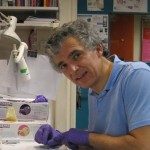Link to Pubmed [PMID] – 20940310
J. Biol. Chem. 2011 Jan;286(1):707-16
Voltage-dependent potassium (Kv) channels are tetramers of six transmembrane domain (S1-S6) proteins. Crystallographic data demonstrate that the tetrameric pore (S5-S6) is surrounded by four voltage sensor domains (S1-S4). One key question remains: how do voltage sensors (S4) regulate pore gating? Previous mutagenesis data obtained on the Kv channel KCNQ1 highlighted the critical role of specific residues in both the S4-S5 linker (S4S5(L)) and S6 C terminus (S6(T)). From these data, we hypothesized that S4S5(L) behaves like a ligand specifically interacting with S6(T) and stabilizing the closed state. To test this hypothesis, we designed plasmid-encoded peptides corresponding to portions of S4S5(L) and S6(T) of the voltage-gated potassium channel KCNQ1 and evaluated their effects on the channel activity in the presence and absence of the ancillary subunit KCNE1. We showed that S4S5(L) peptides inhibit KCNQ1, in a reversible and state-dependent manner. S4S5(L) peptides also inhibited a voltage-independent KCNQ1 mutant. This inhibition was competitively prevented by a peptide mimicking S6(T), consistent with S4S5(L) binding to S6(T). Val(254) in S4S5(L) is known to contact Leu(353) in S6(T) when the channel is closed, and mutations of these residues alter the coupling between the two regions. The same mutations introduced in peptides altered their effects, further confirming S4S5(L) binding to S6(T). Our results suggest a mechanistic model in which S4S5(L) acts as a voltage-dependent ligand bound to its receptor on S6 at rest. This interaction locks the channel in a closed state. Upon plasma membrane depolarization, S4 pulls S4S5(L) away from S6(T), allowing channel opening.
